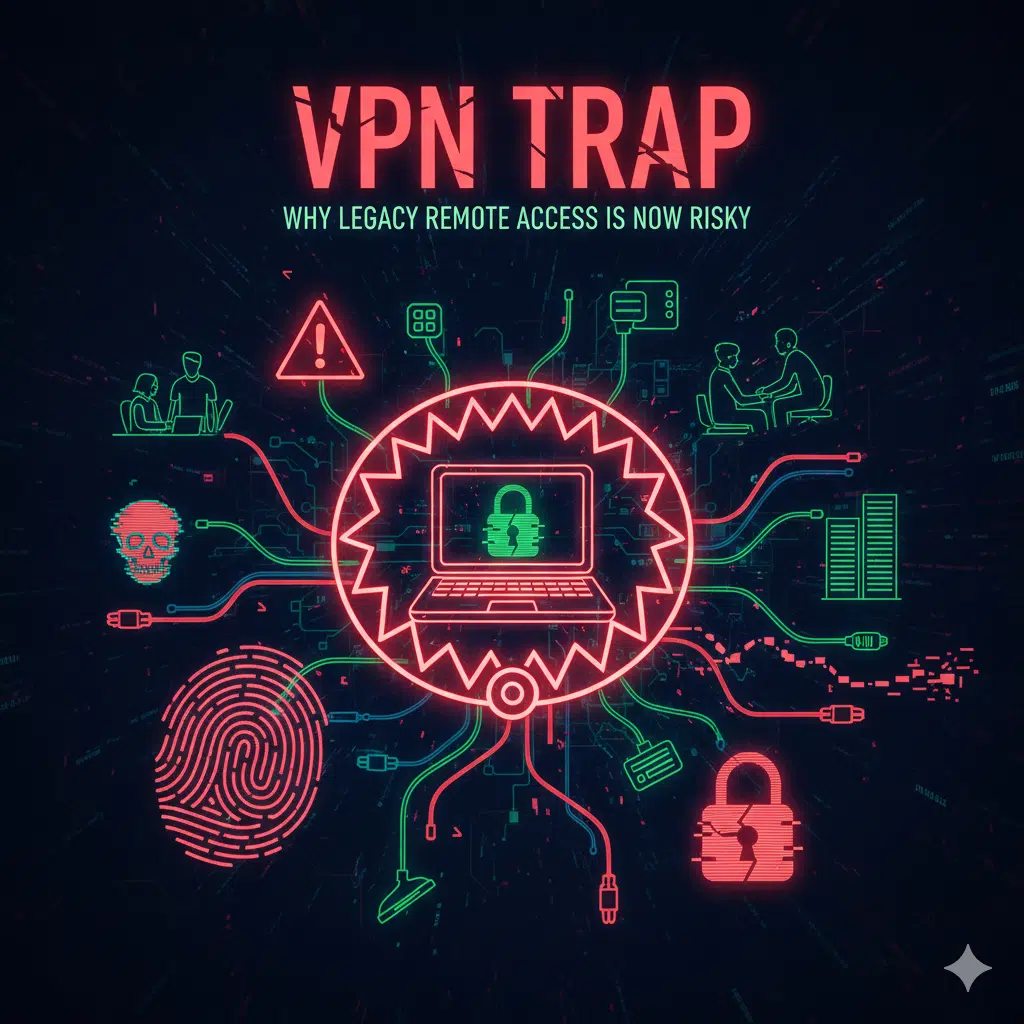Despite their long-standing role in remote access, legacy Virtual Private Networks (VPNs) are increasingly under siege. Recent reports show that these systems, once considered the gold standard for remote connectivity, now represent one of the most attractive entry points for adversaries. With remote work and third-party access expanding rapidly, the accumulated attack surface around traditional VPN architectures is creating what many security experts call a “VPN trap.” This article explores why legacy VPN risk is rising, how attackers exploit it, and what organisations must do to avoid getting caught in the trap.
Why legacy VPNs are vulnerable
Originally designed for simpler network-perimeter models, many legacy VPN solutions grant broad network access once a connection is established. According to one industry blog:
“Legacy VPNs … simply can’t keep up … 91% of security leaders express concerns about VPNs leading to a security breach.”
The issue is not just about age, but architecture: VPNs typically open a tunnel that places the remote user within the corporate network, often with elevated privileges or poorly segmented access. This broad access creates two major dangers:
1. Credential theft and misuse
Attackers frequently target exposed VPN gateways or VPN credentials. A recent incident report from Beazley found that a significant number of ransomware attacks began via compromised credentials used to access VPN or RDP endpoints. The fact that the remote access portal is directly exposed to the internet makes it prime terrain for brute-force, credential stuffing, or zero-day exploits.
2. Lateral movement and deep access
Once inside the network, adversaries can pivot, move laterally, escalate privileges, access sensitive data, and persist. The lack of granular controls in many legacy VPN deployments means attackers face fewer friction points. As one security firm explains:
“The attacker exploited a legacy VPN profile that was not intended to be in use.” (This demonstrates how leftover, unmanaged remote access points amplify risk.
Data and industry view
A recent “VPN Exposure Report 2025” revealed telling statistics:
25% of surveyed organisations cited security and compliance as their primary concern with VPN usage.
69% of respondents feared third-party VPN access could introduce exploitable security gaps.
The prevalence of VPN-related breaches and credential-based attacks continues to climb, and many firms are now shifting toward Zero Trust Network Access (ZTNA) or other modern architectures.
These data points underline that the problem is widespread—not isolated incidents but systemic architectural weakness.
Legacy VPN vs modern secure remote access
Let’s compare the models:
FeatureLegacy VPNModern secure remote access (e.g., ZTNA)Access modelBroad network access once connectedMicro-segmented, least-privilege application accessExposureRequires open ports & tunnelsMinimal exposed ports; internal resources hiddenAuthentication & contextOften single-factor or staticContinuous verification: identity, device, contextLateral movement riskHighLower with application-specific access and segmentationSuitability for cloud & hybridLimitedDesigned for hybrid, cloud and remote ecosystems
According to Palo Alto Networks, legacy VPN and NAC solutions “fall short” in modern threat landscapes because they were never built for the mobile, cloud-first world.
Another industry commentary pointed out that VPNs used to be fine when networks were simpler, but the attack surface has grown dramatically:
“From Ivanti Connect Secure to Cisco … there’s no shortage of examples where VPN portals became open doors.”
What organisations should do now
Given the elevated risk of legacy VPNs, organisations can take several strategic steps:
1. Inventory and audit existing VPN/remote access endpoints
Identify all VPN gateways, their configuration, firmware versions, open ports, what accounts are permitted, vendor access, and how many third-party users connect.
2. Enforce strong authentication and reduce credentials exposure
Ensure multi-factor authentication (MFA) is enforced for all remote access. Monitor for credential stuffing, brute-force attempts, and abandoned accounts that may still have valid access.
3. Segment access and adopt least-privilege
Move away from granting full network access to remote users. Limit connections to only the apps or services required, ideally moving to a Zero Trust access model.
4. Replace or complement legacy VPNs with modern access solutions
Many organisations are now migrating to ZTNA, software-defined perimeters (SDP) or secure remote access clients designed for today’s environment. The blog from Zero Networks states that “once connected through a VPN users typically gain absolute access because you can’t categorize them and classify them well enough.”
5. Patch and monitor diligently
Ensure that remote access gateways are kept up-to-date, vulnerability scans are performed, and logs are continuously monitored for abnormal activity.
Conclusion
If your organisation is still relying heavily on a traditional VPN architecture for remote access, you are living in what the industry now calls a “VPN trap.” What once served as a secure tunnel is now a high-value target for attackers eager to exploit stolen credentials, misconfigured systems, and broad network access. The evidence is clear: the risk of credential theft, lateral movement and full network compromise is higher than in the past. The path forward is to inventory legacy systems, adopt least-privilege access, apply strong authentication and align with a modern secure remote access framework. Legacy VPNs may still work, but they’re no longer enough. It’s time to evolve before someone else makes the decision for you.



